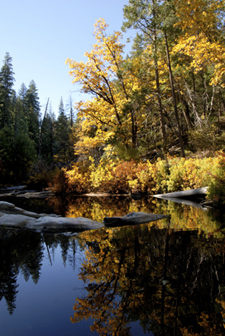Forest management, water yields, and ecosystem services
Summary:
Water provision is an important ecosystem service, particularly in forest ecosystems like those of California's Sierra Nevada mountains. As the climate changes, the way water moves through forests is also changing, which impacts downstream users. This project evaluated trade-offs between different types of forest management and their impacts on water provision.
Investigator:
Kevin O'Hara
Professor
University of California, Berkeley
Project description:
Water is arguably the highest-value ecosystem service associated with the conifer forests of California's Sierra Nevada ecosystem. Yet water provision is vulnerable to changes in energy and water balances associated with climate warming. We have observed more precipitation falling as rain versus snow, earlier snowmelt, and greater summer water deficits. Such climate forcing will impact the water balance for the foreseeable future. However, there is the potential to manage the water balance in forest ecosystems. Trees, the dominant vegetation, are highly productive, form dense canopies, and consequently, use a great deal of water. There is a strong positive correlation between annual net primary productivity (the ultimate measure of the photosynthetic capacity of the ecosystem) and evapotranspiration (the primary cause of water loss). Any manipulation that removes trees reduces the productivity and evapotranspiration, and shifts the balance of energy driving snowmelt, potentially affecting soil-water storage and streamflow.
Water from the Sierra Nevada provides both hydropower and water supply to downstream users. Reducing and restructuring the forest vegetation density can also mitigate the negative impacts of wildfires as well as accomplishing some forest restoration objectives. Forest management that specializes in high value and long-lived forest products can produce the greatest amount of total carbon sequestration benefits when energy use in the consumer sector is considered. Recreation-, conservation-, and biodiversity-related ecosystem values often pose competing aims relative to forest management, but there are few mechanisms to evaluate the trade-offs and complements related to different strategies. Open space easements and hunting leases are two approaches that could provide a model for translating expressed value for other ecosystem services into real financial mechanisms.
This three-part, multi-year and multi-disciplinary research and assessment project addressed issues related to climate warming, vegetation manipulation, and the forest water cycle. The three components were: i) measurements at sites of opportunity where fire or thinning treatments have taken place or are taking place, ii) meta-analysis and modeling using available data to interpret these results, and iii) evaluation of multiple ecosystem services and how multiple service providers such as land and resource owners and managers can effectively interact with service consumers including downstream and downhill residents.



